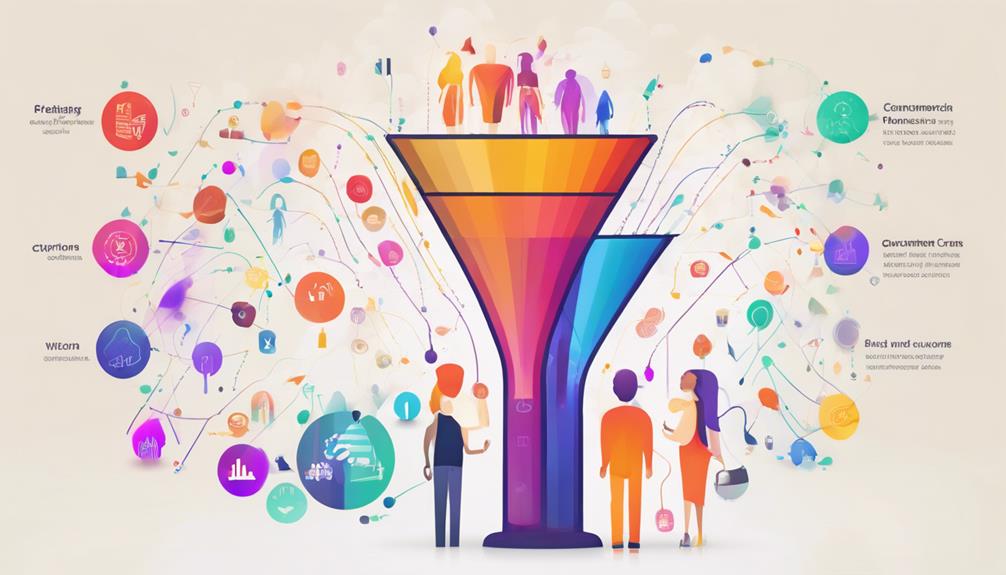When you think about advanced funnel analysis strategies, you're considering a sophisticated toolkit for dissecting customer behaviors and boosting conversions. These strategies go beyond basic analysis, incorporating cohort analysis, behavioral segmentation, and multi-touch attribution to paint a detailed picture of user interactions. By mapping customer journeys and leveraging predictive analytics, you can anticipate future patterns and adjust your approach in real-time. But how do these techniques intertwine to create a seamless strategy that truly works? There's more beneath the surface that could transform your understanding of customer dynamics.
Leveraging Cohort Analysis
When you're aiming to optimize your funnel analysis, leveraging cohort analysis can significantly enhance your insights. Cohort analysis allows you to group users based on shared characteristics or experiences within a specific time frame. By examining these groups, you can identify patterns and trends that might otherwise remain hidden in aggregated data. This method lets you understand how different user cohorts behave over time, enabling you to pinpoint which stage of the funnel needs attention.
To get started, segment your user base into cohorts based on meaningful attributes like acquisition date. For instance, users acquired in January might form one cohort, while those in February form another. Next, track each cohort's progress through your funnel stages. You'll want to monitor metrics such as conversion rates, drop-off points, and customer lifetime value. This analysis helps you identify which cohorts are more successful and why.
By comparing cohorts, you can also assess the impact of changes or experiments on user behavior. Did a new feature launch in March improve retention for users acquired that month? Did a pricing change negatively affect a particular cohort? Armed with this data, you can make informed decisions to enhance your funnel's efficiency.
Furthermore, cohort analysis highlights long-term trends that can inform strategic planning. You'll understand whether improvements are consistent or just temporary spikes. This deeper insight is invaluable for refining your marketing strategies and optimizing user experience.
Embrace cohort analysis to transform your funnel analysis from good to exceptional, driving data-driven decisions that can lead to sustained business growth.
Implementing Behavioral Segmentation

Building on the insights gained from cohort analysis, implementing behavioral segmentation can further refine your funnel optimization strategy. By categorizing users based on their actions and engagement patterns, you can tailor your marketing efforts to meet specific needs and preferences. This approach allows you to identify which behaviors correlate with conversions and optimize accordingly.
To effectively implement behavioral segmentation, start by analyzing user interactions at various funnel stages. Look for patterns that distinguish high-converting users from those who drop off. Using a data-driven approach, segment your audience into distinct groups based on behaviors like page visits, time spent on site, and specific actions taken.
Here's a simple table to guide your segmentation process:
| Behavioral Criteria | Description | Potential Segments |
|---|---|---|
| Page Visits | Frequency and depth of pages visited | Frequent vs. Infrequent |
| Time Spent on Site | Duration of user sessions | Long vs. Short Sessions |
| Actions Taken | Specific actions like clicks, downloads | Action-takers vs. Observers |
| Conversion Path | Typical journeys taken that lead to conversion | Direct vs. Indirect Paths |
| Engagement Channels | Preferred communication channels | Email vs. Social Media Users |
Focus on analyzing which segments are most likely to convert, and tailor your messaging and offers to resonate with those groups. This targeted approach can increase the efficiency of your funnel by ensuring resources are allocated where they'll have the most impact.
Don't forget to regularly update your segmentation as user behaviors evolve. By staying informed and adaptable, you'll maintain a competitive edge and improve your overall funnel performance.
Utilizing Multi-Touch Attribution

Multi-touch attribution revolutionizes how you understand the customer journey by recognizing the impact of multiple touchpoints in driving conversions. Instead of attributing success to a single point of interaction, it considers every relevant touchpoint your customers encounter before making a purchase. This approach provides a comprehensive view of how different channels and interactions contribute to the end goal, offering a more accurate picture of your marketing effectiveness.
To start utilizing multi-touch attribution, identify all the customer interactions across various channels—social media, email, paid ads, and more. By tracking these touchpoints, you can assign a value to each based on its contribution to conversion. This requires setting up robust analytical tools capable of collecting and interpreting data from disparate sources.
Once your data is gathered, employ different attribution models such as linear, time decay, or position-based to analyze touchpoint value. Each model offers unique insights; for instance, a linear model treats all touchpoints equally, while a time decay model gives more weight to the interactions closer to the conversion event. By testing various models, you can discover which provides the most actionable insights for your specific goals.
Regularly analyze and refine these insights to allocate your marketing resources more effectively. By understanding which touchpoints genuinely drive conversions, you can optimize your strategies, improve ROI, and ultimately enhance your customer engagement.
Optimizing Customer Journey Mapping

Effectively optimizing customer journey mapping often hinges on how well you understand and analyze each stage of the customer's interaction with your brand. You need to dissect the journey into distinct phases, examining touchpoints where customers engage with your business. This analysis is crucial for identifying pain points and opportunities for improvement. By leveraging data, you can adjust strategies to enhance customer satisfaction and conversion rates.
Start by mapping out each phase of the journey using detailed analytics. Consider the following table to structure your approach:
| Phase | Key Metrics |
|---|---|
| Awareness | Traffic sources, impressions |
| Consideration | Engagement rate, time spent |
| Conversion | Conversion rate, drop-offs |
| Retention | Repeat purchase rate, churn |
In the awareness phase, focus on whether your marketing efforts reach the right audience. Analyze traffic sources and impressions to understand which channels are most effective. During the consideration phase, measure engagement rates and time spent on your site. This helps pinpoint content that captivates your audience.
As you move to the conversion phase, scrutinize conversion rates and identify where drop-offs occur. This insight allows you to refine the process, minimizing friction points. Finally, in the retention phase, assess repeat purchase rates and churn. This data reveals customer loyalty and helps you implement strategies to enhance retention.
Enhancing Predictive Analytics Techniques

Analyzing customer journey mapping provides valuable insights, but to truly elevate your strategies, enhancing predictive analytics techniques is key. By leveraging predictive analytics, you can anticipate customer behavior, optimize decision-making, and refine your marketing funnels. Start by harnessing machine learning algorithms capable of processing large datasets to identify patterns and predict future actions.
First, focus on data quality. Ensure your data is clean, relevant, and comprehensive. You can't expect accurate predictions if your data inputs are flawed. Use data cleaning techniques to handle missing values, duplicates, and outliers, ensuring your predictive models are built on solid foundations.
Next, segment your audience effectively. By categorizing customers based on behavior, preferences, and demographics, you can tailor predictive models that reflect unique customer journeys. This segmentation allows you to develop targeted marketing strategies that resonate with specific groups.
Incorporate real-time analytics to monitor customer interactions as they happen. This enables you to adjust your strategies dynamically, responding to trends and anomalies swiftly. Real-time data integration ensures your predictions are based on the most current information available.
Experiment with multiple predictive models. Techniques like regression analysis, decision trees, and neural networks each offer different insights. Test various models to identify which best suits your specific funnel analysis needs. Use A/B testing to validate model accuracy and effectiveness.
Conclusion
By diving into advanced funnel analysis strategies, you'll tap into a treasure trove of insights that can transform your marketing approach. Whether you're leveraging cohort analysis or utilizing multi-touch attribution, each technique offers a unique lens on customer behavior. Think of it as your marketing GPS, guiding you through the customer journey. With predictive analytics and real-time data, you'll make informed decisions faster than Doc Brown's DeLorean, ensuring optimized strategies that drive conversions and enhance customer engagement.


Leave a Reply